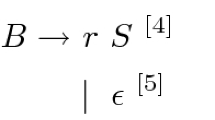Abstract
Static Discontinuity Grammar (SDG) is a type of logic grammar. Its distinctive features are that rules can state dependencies between any two or more subtrees in a derivation tree for a grammatical sentence, and that descriptions are expressed in terms of node domination in the tree. In this paper, we look at different ways of processing SDGs. The parsing methods of top-down depth-first, and left-corner interpreters are examined for SDGs, as well as a compiler that generates code for both analysis and synthesis. We then introduce some examples and use them to compare the efficiency of our different processing methods. We also discuss related work, including the SDG formalism vs. other logic grammar formalisms.
Similar content being viewed by others
Explore related subjects
Discover the latest articles, news and stories from top researchers in related subjects.References
Abramson, H., “Metarules for Efficient Top-down ID-LP Parsing in Logic Grammars,”Technical Report, TR-89-11, University of Bristol, 1989.
Aho, A. V. and Ullman, J. D.,The Theory of Parsing, Translation, and Compiling, Volume 1: Parsing, Prentice-Hall, 1972.
Barton, G. E., “On the Complexity of ID/LP Parsing,”Computational Linguistics, 11, 4, pp. 205–218, 1985.
Brown, C., “Generating Spanish Clitics using Static Discontinuity Grammar,”Ph. D thesis, Simon Fraser University, 1987.
Brown, C., Dahl, V., Massam, D., Massicotte, P., and Pattabhiraman, T., “Tailoring Government and Binding Theory for Use in Natural Language Translation,”Technical Report, LCCR 86-4, Simon Fraser University, 1986.
Chomsky, N.,Lectures on Government and Binding, the Pisa Lectures, 2nd (revised) Edition, Foris Publications, Holland, 1982.
Colmerauer, A., “Metamorphosis Grammars,” inLecture Notes in Computer Science (L. Bolc ed.), Springer-Verlag, 1978.
Crocker, M., “A principle-based system for natural language analysis and translation,”Master’s thesis, University of British Columbia, 1988.
Dahl, V., “More on Gapping Grammars,”Proceedings International Conference on V Generation Computer Systems, Tokyo, 1984.
Dahl, V., “Gramaticas discontinuas: una herramienta computacional con aplicaciones en la teoria de Reccion y Ligamiento,”Revista Argentina de Lingülstica, 2, 2, pp. 375–392, 1986.
Dahl, V., “Representing Linguistic Knowledge through Logic Programming,”Fifth International Conference/Symposium on Logic Programming, Seattle, August, 1988.
Dahl, V., “Static Discontinuity Grammars for Government and Binding Theory,”Proc. Workshop ‘Informatique and langue naturelle’, Université de Nantes, October, 1988.
Dahl, V., “Discontinuous Grammars,”Computational Intelligence, 5, 4, pp. 161–179, 1989.
Dahl, V., “Compiling Static Discontinuity Grammars,”Extended abstract presented at the Workshop on Prolog as the Implementation Language for Natural Language, Sweden, 1989.
Dahl, V., “Describing Linguistic Knowledge about Constraints in User-friendly Ways,”International Journal of Expert Systems: Research and Applications, to appear.
Dahl, V. and Abramson, H., “On Gapping Grammars,”Proceedings, Second International Logic Programming Conference, Uppsala, Sweden, pp. 77–88, 1984.
Dahl, V. and Massicotte, P., “Interpreting Static Discontinuity Grammars in Prolog,”Applied Mathematics Letters, 3, 1990.
Dahl, V. and McCord, M., “Treating coordination in logic grammars,”American Journal of Computational Linguistics, 9, pp. 69–91, 1983.
Dahl, V., Brown, C., and Hamilton, S., “Static Discontinuity Grammars and Logic Programming,”Technical Report, LCCR 86-17, Simon Fraser University, 1986.
Dahl, V. and Saint-Dizier, P., “Constrained Discontinuous Grammars — A Linguistically Motivated Tool for Processing Language,”Technical Report, LCCR 86-11, Simon Fraser University, 1986.
Gazdar, G., Klein, E., Pullum, G., and Sag, I.,Generalized Phrase Structure Grammar, Basil Blackwell, London, 1985.
Greibach, S. and Hopcroft, J., “Scattered Context Grammars,”Journal of Computer and System Sciences, 3, pp. 233–247, 1969.
Johnson, M., “Parsing with Discontinuous Constituents,”Proceedings of the 23rd Annual Meeting of the Association for Computational Linguistics, 1985.
Johnson, M., “The Use of Knowledge of Language,”Technical Report, Brain and Cognitive Sciences, M. I. T., 1987.
Monteiro, L., “Distributed Logic: A Logical System for Specifying Concurrency,”Technical Report 5/81, Centro de Informatica, Universidade Nova de Lisboa, 1981.
Pereira, F. C. N., “Extraposition Grammars,”American Journal for Computational Linguistics, 7, pp. 243–256, 1981.
Pereira, F. C. N. and Shieber, S.,Prolog and Natural Language Analysis, Center for the Study of Language and Information, Stanford, 1987.
Pereira, F. C. N. and Warren, D. H. D., “Definite Clause Grammars for Language Analysis — A Survey of the Formalism and a Comparison with Transition Networks,”Artificial Intelligence, 13, pp. 231–278, 1980.
Popowich, F., “Unrestricted Gapping Grammars,”Computational Intelligence, 2, 1, pp. 28–53, 1986.
Rosenkrantz, D. J. and Lewis II, P. M., “Deterministic Left Corner Parser,”IEEE Conference Record of the 11th Annual Symposium on Switching and Automata Theory, pp. 139–152, 1970.
Saint-Dizier, P., “Dislog: Programming in Logic with Discontinuities,”Technical Report, LCCR 87-13, Simon Fraser University, 1987.
Saint-Dizier, P., “Contextual Discontinuous Grammars,” inNatural Language Understanding and Logic Programming II (Dahl and St-Dizier ed.), North-Holland, 1988.
Sharp, R., “A Model of Grammar Based on Principles of Government and Binding,”Master’s thesis, University of British Columbia, 1985.
Stabler, E. P. Jr., “Restricting Logic Grammars with Government-Binding Theory,”Journal of Computational Linguistics, pp. 1–10, 1987.
Stabler, E. P. Jr., “Parsing with Explicit Representations of Syntactic Constraints,” inNatural Language Understanding and Logic Programming II (Dahl and St-Dizier ed.), North-Holland, 1988.
Sterling, L. and Shapiro, E.,The Art of Prolog, The MIT Press, 1986.
Author information
Authors and Affiliations
Additional information
This research is supported by Fred Popowich’s research fellowship from the Advanced Systems Institute of British Columbia and by his Natural Sciences and Engineering Research Council of Canada Grant No. OGP0041910, by Veronica Dahl’s NSERC grant 06-4244, and also partially by her Center for Systems Science Grant No. 4038, in view of collaboration with Centre Canadien de Recherche en Informatisation du Travail. The views expressed in this article are strictly those of the authors.
About this article
Cite this article
Dahl, V., Popowich, F. Parsing and generation with Static Discontinuity Grammars. New Gener Comput 8, 245–274 (1990). https://doi.org/10.1007/BF03037519
Received:
Revised:
Issue Date:
DOI: https://doi.org/10.1007/BF03037519




